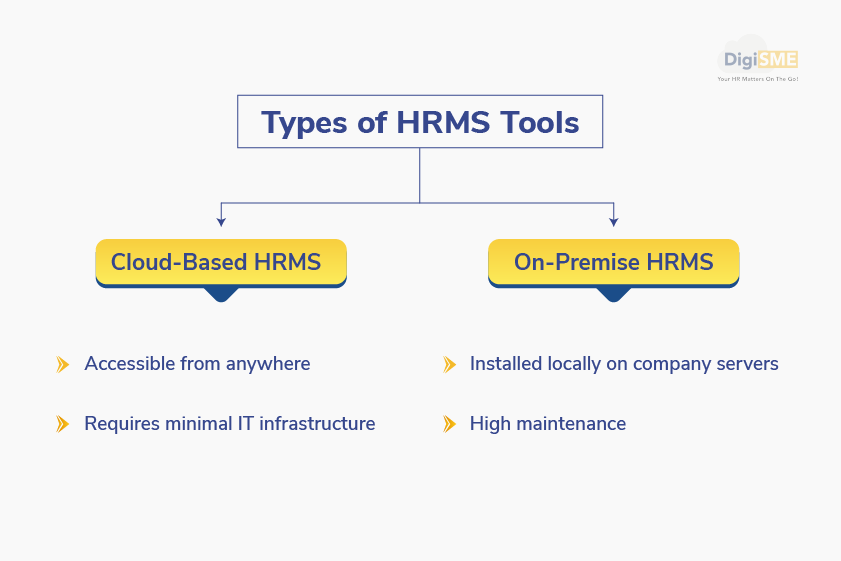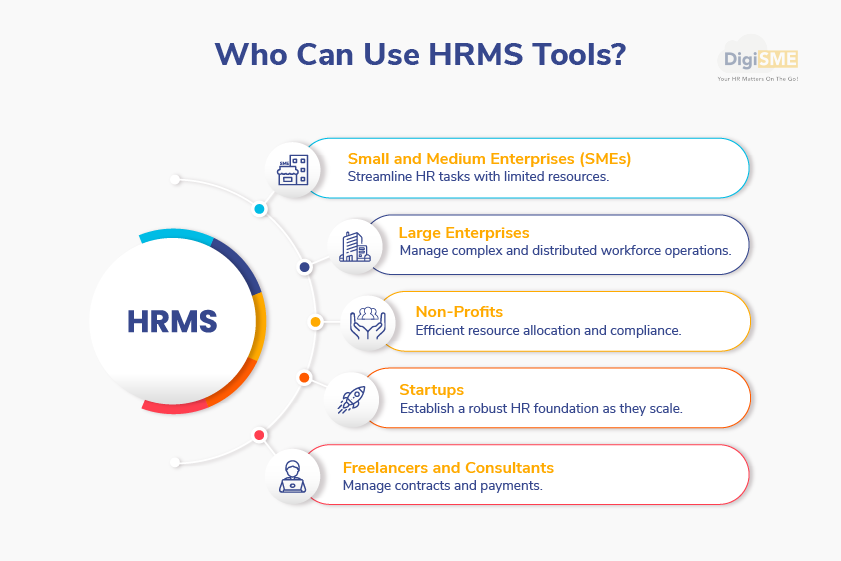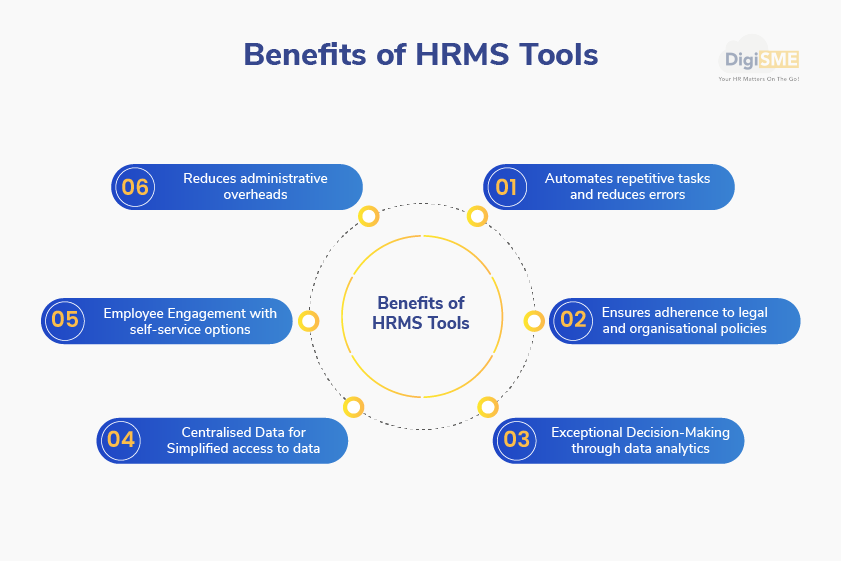Human Resource Management Systems (HRMS) have transformed how businesses manage their workforce. These tools streamline HR processes, reduce manual effort, and ensure compliance with labour laws. By automating routine tasks like payroll, attendance, and performance management, HRMS tools free up valuable time for HR teams to focus on strategic initiatives. This leads to improved employee engagement, better decision-making through data insights, and, ultimately, higher productivity for your business.
Table of Contents
What Are HRMS Tools?
HRMS tools are software applications to manage human resources efficiently. Various HR functions like recruitment, onboarding, training, payroll, and compliance are integrated into a centralised platform. Businesses can effortlessly handle employee-related tasks while maintaining records and smooth communication across departments.

Features of HRMS Tools
Employee Database Management:
It is a centralised repository for staff information, such as personal details, employment history, and documents. HRs and management teams can easily access the reports whenever necessary.
Payroll Management:
From salary calculations to tax deductions and statutory compliance, payroll handling will become effortless with technology. HR teams do not have to take a toll in evaluating the number of leaves taken, working hours, and other allowances/deductions before dispersing the salary on the last few days of the month.
Attendance and Leave Tracking
Working hours monitoring, leave request management and detailed report generation are all performed by technology in many organisations. Attendance management software has the necessary tools for effortless tracking of employee time-in/out, OT, early arrivals, and late comers.
Performance Management
Evaluating employee performance with technology reduces the work of supervisors and HR departments. Tools incorporate features such as goal setting, appraisal templates, multi-level feedback mechanisms, scorecards and more.
Recruitment and Onboarding
Applicant tracking systems are helpful in screening thousands of candidate applications. Onboarding, orientation, and other hiring workflows can utilise HRMS tools to provide exclusive onboarding for new hires.
Employee Self-Service Portal
With the employee self-service portal (ESS), companies are trying to provide staff with complete access to their data and allow them to perform tasks like applying for leaves, regularising attendance hours, and viewing payslips independently.
How to Use an HRMS Tool?
Research and Purchase
Search for the best HRMS tools available in the industry before purchase. An HR software vendor may offer onboarding, payroll and attendance, but another vendor can offer appraisal modules with claims reimbursement. It is crucial to analyse which is the best fit for the organisation.
Companies hiring field executives may consider investing in employee field tracking software that allows staff to mark their attendance when they are out of the office.
Setup and Customisation
Once the purchasing is done, it is important to configure the HRMS tool according to the organisational requirements. From company structure to HR policies, the tool should be curated to fit the firm’s workflows. HR software vendors with dedicated implementation teams will provide a complete walkthrough of the product and offer end-to-end support.
Data Migration
Every organisation will have workforce management systems, which can be traditional or technological. Transferring the employee data into the system is way too crucial. From personal details, working hours and other information must be moved to the new HR software.
Training
Unfamiliarity of new systems often result in failure of HR transformation in many organisations. If a firm is not aware of the HR software usage (both employees and employers), the management’s decision of digital transformation will go in vain. This is why setting and forgetting in HRMS is not considered ideal.
Read more! Why “Set it and Forget it” Doesn’t Work for HRMS
Automation
Once the system is up and running, all manual systems like attendance, payroll and performance evaluation can be automated.
Analytics and Reporting
It is not just about HR automation but using the HR data to make decisions. From monitoring trends to creating reports, it is easier for the management to analyse valuable insights like attendance patterns, staff who always arrive on time and more.
Continuous Support
Vendor support is significant for the efficient use of HR software. Providing updates and troubleshooting the issues are important aspects of any dedicated support team.
What Is the Difference Between HRMS and ERP?
HRMS focuses only on automating workforce management tasks, while Enterprise Resource Planning Software incorporates several business operations, such as supply chain, inventory management, and finance. Many large corporations prefer ERP systems, which include HRMS tools. However, small and medium-sized businesses prefer HR software with curated features suitable for their organisations and HR departments.

Things to Consider When Selecting HRMS Tools for Your Company
Scalability
Scalability is one of the essential attributes to consider when choosing HRMS tools. When an organisation grows, it is difficult to keep changing its systems. A reliable HRMS software is scalable allowing management to include new staff, upgrade workforce handling process and frequent software updates. There is no need to switch systems as the organisation evolves, saving time, money, and effort. For example, if a team grows from 50 to 500 employees, the tool should be capable of handling the increased load without any hindrance.
User-Friendliness
A user-friendly HRMS is crucial for efficient adoption and use across all levels of your organisation. The interface should be intuitive, minimising the learning curve for your HR team and employees. Features like easy navigation, clear dashboards, and self-service portals can make everyday tasks—like applying for leave or viewing payroll information—simple and efficient. A tool requiring extensive training or technical expertise might create delays and resistance among users.
Integration
Evaluate whether the HRMS can integrate smoothly with your existing tools and systems, such as payroll software, accounting platforms, or project management tools. Seamless integration reduces redundancies and ensures a unified data flow across departments. For example, an HRMS that syncs with your payroll system can automate salary calculations based on attendance and leave, eliminating the need for manual data entry and reducing errors.
Cost
Assess the total cost of ownership, which includes more than just the upfront subscription fees. Factor in costs for setup, implementation, customisation, training, maintenance, and future upgrades. Additionally, consider whether the tool’s pricing model aligns with your budget—some HRMS tools charge per user, while others offer flat rates. Weigh the cost against the features and benefits provided to ensure you get value for your investment.
Security
HRMS tools handle sensitive employee data, including personal details, payroll information, and performance records. Therefore, data security should be a top priority. Look for tools that offer advanced encryption, multi-factor authentication, and compliance with data protection regulations such as GDPR, HIPAA, or ISO certifications. A secure HRMS minimises the risk of data breaches, safeguarding your organisation’s reputation and your employees’ trust.
Customisation
Every organisation has unique HR needs, and a one-size-fits-all solution may not work. Choose an HRMS that allows you to customise workflows, forms, and reports to match your specific processes. For example, you might want to implement a customised approval workflow for leave requests or set up unique performance appraisal metrics. Customisation ensures the tool aligns perfectly with your business requirements, improving efficiency and usability.

Wrapping Up
HRMS tools are essential for modern businesses looking to optimise their workforce management processes. Investing in the right HRMS tool can boost productivity, streamline operations, and create a more engaged and efficient workplace. With these HR tools available, tasks will become significantly easier. Try DigiSME HRMS software, designed to meet the specific needs of organisations across the country. Simply reach out to our customer support team to learn more about our HR software. By exploring the various software modules, choose the ideal people management system that best fits your organisation’s requirements.

